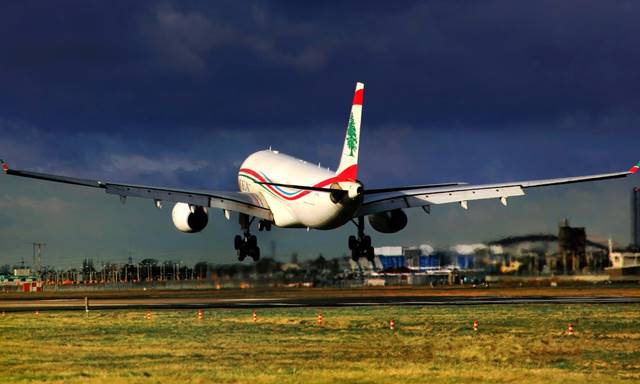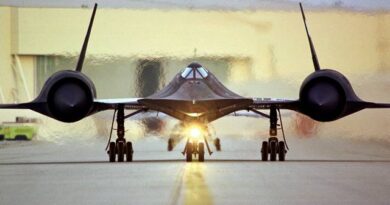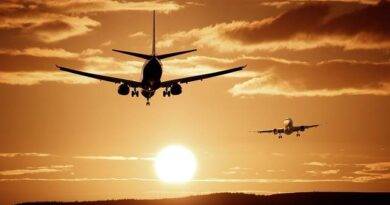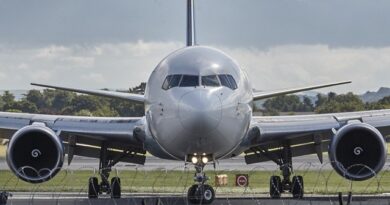Noise Pollution Levels by Aircraft Types
Airplane noise can be a real pain, especially for those living near airports or flight paths. Did you know different aircraft types generate vastly different noise levels? Buckle up as we explore the decibel differences between your favorite (and not-so-favorite) airplanes! Aircraft noise has been the subject of many researches for years due to the pollution of the noise it gives to the environment. However, there are gratifying results on this subject in an analysis made by Eurocontrol. Let’s take a look together.
Over the years, advances in both engine technologies and aircraft aerodynamics have brought about a serious decrease in noise levels.
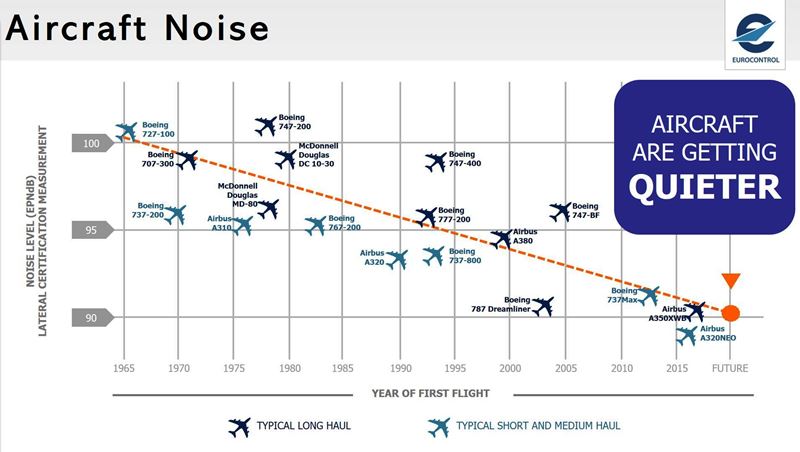
In a chart prepared by Eurocontrol, it is possible to clearly see the decrease in the noise level of aircraft engines. The results in the graph are prepared according to the Effective perceived noise in decibels (EPNdB) unit of measure. According to this, the noise level of aircraft such as the Boeing 727 and Boeing 747-200, which are now few in the skies, is above 100 decibels.
The noise level of Airbus A320 and Boeing 737-800 type aircraft, which are widely used in the medium category all over the world, is around 93-94 decibels. Noise level has decreased to around 90 decibels in Airbus A350, Boeing 787, Airbus A320neo and Boeing 737 MAX aircraft, which are the most modern passenger aircraft today. In fact, the noise level fell below 90 decibels on the A320neo.
Lets delve more into the topic of noise pollution levels by aircraft types and provide an overview of the key factors and reference points to consider.
Beyond the Numbers: Factors Affecting Noise Perception
Remember, decibels are just part of the story. Noise perception is also influenced by:
- Engine type: Turbofans (jets) are generally louder than turboprops.
- Operating procedures: Takeoff and landing generate the most noise.
- Flight path: Altitude and distance from the observer play a big role.
- Individual sensitivity: Some people are more bothered by noise than others.
Decibel Levels and Measurement:
Decibels (dB) are used to measure sound intensity, including aircraft noise. A logarithmic scale is employed, with each increase of 10 dB representing a tenfold increase in sound intensity. The reference point for aviation noise is typically measured at a distance of 2,000 feet (609 meters) from the runway threshold.
Aircraft Noise Classification:
Different aircraft types generate varying levels of noise due to factors such as engine design, size, and operational characteristics. To classify aircraft noise, the International Civil Aviation Organization (ICAO) has established the Balanced Approach, which categorizes aircraft into four noise levels: Chapter 3, Chapter 4, Stage 3, and Stage 4.
Chapter 3: This classification refers to older subsonic jet aircraft that comply with ICAO’s noise standards from 1977. They are no longer produced but still operate in some regions.
Chapter 4: These are newer subsonic jet aircraft designed to comply with more stringent ICAO noise standards set in 2006. They generally produce lower noise levels than Chapter 3 aircraft.
Stage 3: Stage 3 refers to older subsonic aircraft with turbojet or fanjet engines, commonly used in commercial aviation. They meet noise standards established by the United States Federal Aviation Administration (FAA) and are gradually being phased out.
Stage 4: Stage 4 aircraft are the latest generation of subsonic aircraft designed to comply with even more stringent noise standards. They employ advanced engine technologies, such as noise-reducing chevrons and high bypass ratios, to minimize noise emissions.
Noise Reduction Initiatives:
The aviation industry has been actively engaged in noise reduction initiatives. These include technological advancements, improved operational procedures, and airport planning. For instance, the use of noise-reducing engine designs, such as hush kits and geared turbofan engines, has significantly contributed to lowering noise levels.
Understanding Decibels (dB):
Decibels measure sound level. Here’s a simplified breakdown:
- Below 50 dB: Quiet, like normal conversation.
- 50-70 dB: Moderate noise, like traffic or an appliance.
- 80-90 dB: Potentially harmful with prolonged exposure.
- Above 100 dB: Can cause immediate hearing damage.
Impact on Communities:
Excessive aircraft noise can have adverse effects on the well-being and quality of life for individuals residing near airports. It can disrupt sleep patterns, increase stress levels, and even lead to long-term health issues. Thus, it is essential to monitor and regulate noise pollution to minimize its impact on communities.
Conclusion: Understanding noise pollution levels by aircraft types is crucial for effective noise management strategies. The classification systems provided by organizations like ICAO and FAA enable the identification and regulation of aircraft noise emissions. By adopting advanced technologies and operational practices, the aviation industry continues to make significant strides in reducing noise pollution. Balancing the needs of aviation with the well-being of surrounding communities remains an ongoing challenge, and continuous efforts are required to mitigate the impact of aircraft noise pollution.
References:
- International Civil Aviation Organization (ICAO) – https://www.icao.int
- United States Federal Aviation Administration (FAA) – https://www.faa.gov
- Schulte-Fortkamp, Brigitte. “Aircraft noise: a health issue.” Bulletin of the World Health Organization 94.6 (2016): 421.
- European Commission. “Environmental Noise Directive 2002/49/EC.” European Union (2002).
- Eurocontrol. “Aircraft Noise Management Guidelines.” Version 4.1
For more articles click.
